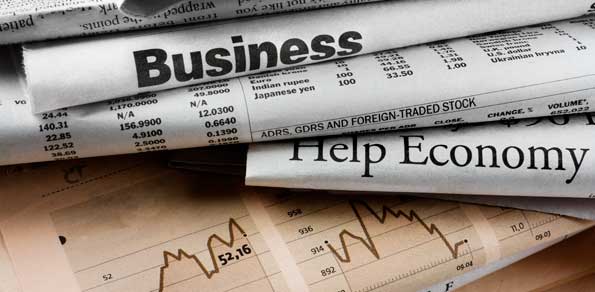As I research each day, I copy or jot down items that I find about currencies, economic indicators, reports and news, so at the end of the day when I have to start to do my fundamental analysis for each of the major currency pairs and several commodities I have easy access to the material I have read all day. I some time publish these and call them notes from my desk. It seems that a lot of investors like to just see what I find each day, so I am sharing them with you. There is a overall order to them by markets, but they are not sorted. It’s like reading someone’s diary or notes so welcome to my desk daily.
The labor market is improving at a moderate pace, with private payrolls in March notching more than two years of gains, according to a monthly report released Wednesday by payrolls-processor Automatic Data Processing Inc.
The Institute for Supply Management’s services-sector index for March fell to 56.0% from 57.3% in February, the private group reported Wednesday. The gauges for new orders and production fell, accounting for most of the decline.
Despite the moderate pace of the recovery, there were many reasons to be optimistic about the outlook, Treasury Secretary Timothy Geithner said Wednesday. In a speech to The Economic Club of Chicago, Geithner said that the economy was “making a lot of progress” working down excess debt. Household debt is down 17 percentage points relative to income since before the crisis, Geithner said. At the same time, financial sector leverage is down “substantially” and credit is expanding, he said. The challenge facing the American economy is not primarily about the health of the business community,
The number of mortgage applications filed in the U.S. last week rose 4.8% from the prior week, the Mortgage Bankers Association said Wednesday, as re-financings picked up following six straight weeks of declines.
The European Central Bank leaves its key lending rate unchanged at 1%, as expected. European Central Bank President Mario Draghi said Wednesday in his monthly news conference that governments in the euro zone needed to meet their responsibilities for ensuring sound structural reforms and fiscal positions, and that these were essential for economic growth. He also said that while funding conditions for banks in the region had generally improved, it was now necessary for financial institutions to strengthen their resilience further. Draghi said that any talk of an “exit strategy” in terms of ECB monetary policy is premature. Draghi said that inflation in the euro area is expected to stay above 2% in 2012.
Yields on Italian and Spanish government bonds surged on Wednesday after Spain saw borrowing costs rise in its first auction demand since presenting its latest austerity budget last week
The final reading of the Markit euro-zone composite purchasing managers index, or PMI, for March rose from a preliminary estimate but still pointed to a contraction in business activity in the 17-nation region last month and over the first.
A gauge of activity in Britain’s dominant services sector unexpectedly rose in March, data showed Thursday. The CIPS/Markit purchasing managers index, or PMI, for the sector rose to 55.3 from a reading of 53.8 in February.
Chris Williamson of Markit said that the strength of the economy as reflected in these surveys would stay the BOE MPC’s hand on further asset purchases in coming months.
[quote]PMI data signalled that UK economic growth picked up in March to round off the strongest quarter for a year. The surveys therefore indicate that the UK economy has escaped a slide back into recession, and also suggest that the Bank of England will hold off on further asset purchases unless the economic situation deteriorates in coming months[/quote]
Williamson said that the upturn in business confidence in both construction and service sectors bodes well for future growth, though he warned that soft underlying order books might weigh on manufacturing. The Queen’s Jubilee celebrations could also be expected to dampen GDP growth, Williamson said.
[quote]There remains a strong risk that, unless business activity picks up further, the economy could contract again in the second quarter. Despite this, the strengthening of the economy in March suggests that the Bank of England’s Monetary Policy Committee will leave policy unchanged and is likely to revise up its growth forecast in the spring Inflation Report. Further quantitative easing is only likely if the economic data turn down meaningfully in coming months.[/quote]
Gold and silver futures sank Wednesday, joining a selloff in stocks and commodities after minutes from the U.S. Federal Reserve’s latest policy meeting undercut expectations for further monetary stimulus. Gold for June delivery slumped $52, or 3.1%, to $1,620 an ounce on the Comex division of the New York Mercantile Exchange. Silver futures also posted sharp losses, with the May contract falling $1.69, or 5%, to $31.57 an ounce.
“What we see today is a rather broad-based sell-off in financial markets,” said Carsten Fritsch, an analyst at Commerzbank. “The trigger was yesterday’s Fed minutes which dashed hopes of (a third round of quantitative easing.)”
Minutes from the Federal Reserve Tuesday signalled that central-bank officials were less interested in another round of large-scale purchase of bonds.
The losses for precious metals came as European stocks slumped and U.S. equities opened sharply lower. The Dow Jones Industrial Average dropped 100 points in early trade. This behaviour “suggests gold is still mainly driven by speculative elements, not by long-term investors,” said Commerzbank’s Fritsch. The impact of a higher U.S. dollar on the gold price will be particularly pronounced given that a large majority of gold is invested in the U.S. strategists at the National Australia Bank said. “In the medium-to-longer term, we expect more certainty surrounding the European sovereign debt situation to emerge, while a relatively stronger U.S. dollar and a return to fundamentals should also help to lower prices,” the strategists added.
The National Australia Bank forecast gold to trade at around $1,620 an ounce over the June quarter.
The USD was trading a bit lower against the yen on Wednesday; erasing earlier gains after the Federal Reserve said it was growing increasingly unlikely to roll out monetary stimulus programs to spur the economy, which sparked a global dollar rush.
In Asian trading on Wednesday, USD/JPY hit 82.64, down 0.20%, up from a low of 82.63 and off a high of 82.94. The duo sought to test support at 81.63, Tuesday’s low, and resistance at 83.30, Monday’s high.
The dollar soared upon release of the Federal Reserve’s minutes of its last meeting, which revealed voting members are increasingly inclined to forgo fresh monetary stimulus measures. Since the recession and ensuing sluggish recovery, the Federal Reserve has swollen its balance sheet by well over USD2 trillion via buying assets from banks like bonds in order to steer the economy away from deflationary contraction and closer towards growth and hiring.
The New Zealand dollar has tumbled after the Federal Reserve ruled out any additional monetary stimulus. This removed a threat to the US dollar, which rallied against most major currencies. The New Zealand dollar fell as low as 81.65 US cents after the release of minutes from the Fed’s March 13 meeting, from 82.34 US cents immediately before the announcement. The kiwi traded at 81.82 cents at 8am.
Investors’ hopes were diminished that the Fed might add possible monetary stimulus to the world’s largest economy. If the US data continues to get better we will eventually see the kiwi dollar improve against the US.
The Australian dollar fell to its lowest level since January, after the US Federal Reserve indicated it would not be taking action to further stimulate the American economy. The Aussie dollar was trading at $US1.0294, having fallen from an opening price of $1.0331 on the news. Australia’s trade deficit has narrowed in February, against expectations of a surplus, according to data from the Australian Bureau of Statistics. According to the figures, Australia’s trade deficit for the month of February was a seasonally adjusted $480 million, an improvement of $491 million on last month. The result follows a downwardly-revised deficit of $971 million in January. Economists’ forecasts had centered on a surplus of $1.1 billion in February.
Activity in the Australian services sector contracted in March, as trading conditions weakened and the local currency stayed strong, a private survey shows. The Australian Industry Group/Commonwealth Bank Australian Performance of Services Index (PSI) rose 0.3 points to 47.0 points in March. A reading below 50 indicates a contraction in activity. Only two of the nine sub-sectors covered by the survey recorded rises in activity. They were finance and insurance, and personal and recreational services.
The high (Australian) dollar is thwarting the prospects for trade-exposed service businesses and a lack of confidence among households is holding back the retail sector and service businesses. Americans aren’t receiving meaningful pay increases. Gas prices are high. And Europe’s debt crisis could weigh on the US economy. Most economists don’t think Fed officials will change their interest-rate policy at the next meeting on April 24 to 25. But pressure could build for the Fed to begin raising rates sooner if the pace of economic growth picks up.
US consumers boosted their spending in February by the most in seven months, raising expectations that the economy grew at a stronger pace in the first quarter the year. The Commerce Department will release its growth estimate for the January-March quarter on April 27. Many people are more confident in the economy, despite stagnant wages and higher gas prices. The University of Michigan Consumer Sentiment Survey index rose last month to its highest level since February 2011. Fed chairman Ben Bernanke said the combination of modest economic growth and rapid declines in unemployment is something of a puzzle. Normally, it takes roughly four per cent annual growth.





